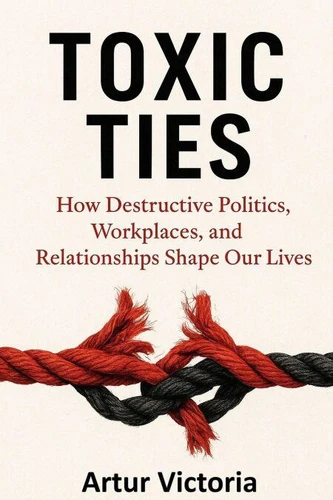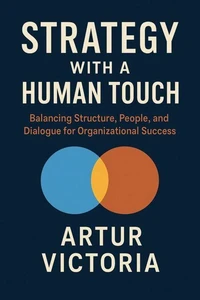Nouveauté
Toxic Ties - How Destructive Politics, Workplaces and Relationships Shape Our Lives. Education, #7
Par :Formats :
Disponible dans votre compte client Decitre ou Furet du Nord dès validation de votre commande. Le format ePub protégé est :
- Compatible avec une lecture sur My Vivlio (smartphone, tablette, ordinateur)
- Compatible avec une lecture sur liseuses Vivlio
- Pour les liseuses autres que Vivlio, vous devez utiliser le logiciel Adobe Digital Edition. Non compatible avec la lecture sur les liseuses Kindle, Remarkable et Sony
- Non compatible avec un achat hors France métropolitaine
 , qui est-ce ?
, qui est-ce ?Notre partenaire de plateforme de lecture numérique où vous retrouverez l'ensemble de vos ebooks gratuitement
Pour en savoir plus sur nos ebooks, consultez notre aide en ligne ici
- FormatePub
- ISBN8232445737
- EAN9798232445737
- Date de parution13/09/2025
- Protection num.Adobe DRM
- Infos supplémentairesepub
- ÉditeurHamza elmir
Résumé
The word has become cultural shorthand - toxic politics, toxic workplaces, toxic friendships, toxic social media - but the widespread use of the term is more than just a linguistic fad. It signals a collective recognition that something is deeply wrong with the relationships that shape both our private lives and our public systems. At first glance, these forms of toxicity may seem unrelated. An intimidating boss seems a far cry from a corrupt prime minister.
A manipulative friend has little to do with an authoritarian regime. A violent partner seems to have nothing in common with an online disinformation campaign. But beneath the surface, these destructive dynamics are not at all separate. This book argues that toxicity is best understood as a systemic condition, not as a collection of isolated incidents. Like poison spreading through water, toxic dynamics seep into the ecosystems they inhabit.
A work culture based on fear and favouritism is not confined to the office; it spreads to homes, families, and communities. Corruption in politics erodes public trust and normalises dishonesty, which then seeps into business practices, educational environments, and even personal interactions. In this sense, toxic ties are interconnected threads of the same web. They connect the personal to the political, the intimate to the institutional.
When we zoom out, patterns emerge:Abuse of power, whether at home or in parliament, thrives on secrecy and silence. Manipulation, whether by a controlling partner or a state propaganda machine, relies on distorting reality until people lose confidence in their own judgement. Favouritism, whether in the workplace or in government contracts, undermines justice and divides communities. The repetition of these patterns across different domains shows us that toxicity is not random.
It is structured. It is learned, transmitted and reinforced until it seems normal - until people begin to confuse abuse with leadership, intimidation with discipline, and control with love.
A manipulative friend has little to do with an authoritarian regime. A violent partner seems to have nothing in common with an online disinformation campaign. But beneath the surface, these destructive dynamics are not at all separate. This book argues that toxicity is best understood as a systemic condition, not as a collection of isolated incidents. Like poison spreading through water, toxic dynamics seep into the ecosystems they inhabit.
A work culture based on fear and favouritism is not confined to the office; it spreads to homes, families, and communities. Corruption in politics erodes public trust and normalises dishonesty, which then seeps into business practices, educational environments, and even personal interactions. In this sense, toxic ties are interconnected threads of the same web. They connect the personal to the political, the intimate to the institutional.
When we zoom out, patterns emerge:Abuse of power, whether at home or in parliament, thrives on secrecy and silence. Manipulation, whether by a controlling partner or a state propaganda machine, relies on distorting reality until people lose confidence in their own judgement. Favouritism, whether in the workplace or in government contracts, undermines justice and divides communities. The repetition of these patterns across different domains shows us that toxicity is not random.
It is structured. It is learned, transmitted and reinforced until it seems normal - until people begin to confuse abuse with leadership, intimidation with discipline, and control with love.
The word has become cultural shorthand - toxic politics, toxic workplaces, toxic friendships, toxic social media - but the widespread use of the term is more than just a linguistic fad. It signals a collective recognition that something is deeply wrong with the relationships that shape both our private lives and our public systems. At first glance, these forms of toxicity may seem unrelated. An intimidating boss seems a far cry from a corrupt prime minister.
A manipulative friend has little to do with an authoritarian regime. A violent partner seems to have nothing in common with an online disinformation campaign. But beneath the surface, these destructive dynamics are not at all separate. This book argues that toxicity is best understood as a systemic condition, not as a collection of isolated incidents. Like poison spreading through water, toxic dynamics seep into the ecosystems they inhabit.
A work culture based on fear and favouritism is not confined to the office; it spreads to homes, families, and communities. Corruption in politics erodes public trust and normalises dishonesty, which then seeps into business practices, educational environments, and even personal interactions. In this sense, toxic ties are interconnected threads of the same web. They connect the personal to the political, the intimate to the institutional.
When we zoom out, patterns emerge:Abuse of power, whether at home or in parliament, thrives on secrecy and silence. Manipulation, whether by a controlling partner or a state propaganda machine, relies on distorting reality until people lose confidence in their own judgement. Favouritism, whether in the workplace or in government contracts, undermines justice and divides communities. The repetition of these patterns across different domains shows us that toxicity is not random.
It is structured. It is learned, transmitted and reinforced until it seems normal - until people begin to confuse abuse with leadership, intimidation with discipline, and control with love.
A manipulative friend has little to do with an authoritarian regime. A violent partner seems to have nothing in common with an online disinformation campaign. But beneath the surface, these destructive dynamics are not at all separate. This book argues that toxicity is best understood as a systemic condition, not as a collection of isolated incidents. Like poison spreading through water, toxic dynamics seep into the ecosystems they inhabit.
A work culture based on fear and favouritism is not confined to the office; it spreads to homes, families, and communities. Corruption in politics erodes public trust and normalises dishonesty, which then seeps into business practices, educational environments, and even personal interactions. In this sense, toxic ties are interconnected threads of the same web. They connect the personal to the political, the intimate to the institutional.
When we zoom out, patterns emerge:Abuse of power, whether at home or in parliament, thrives on secrecy and silence. Manipulation, whether by a controlling partner or a state propaganda machine, relies on distorting reality until people lose confidence in their own judgement. Favouritism, whether in the workplace or in government contracts, undermines justice and divides communities. The repetition of these patterns across different domains shows us that toxicity is not random.
It is structured. It is learned, transmitted and reinforced until it seems normal - until people begin to confuse abuse with leadership, intimidation with discipline, and control with love.

















